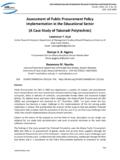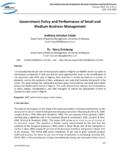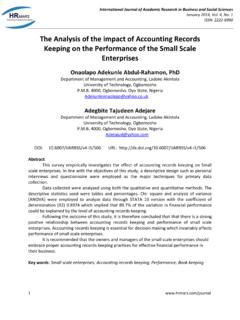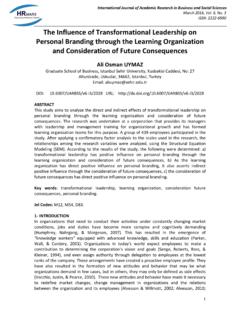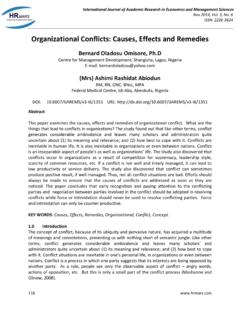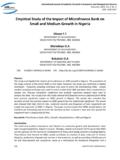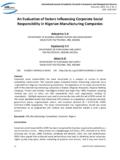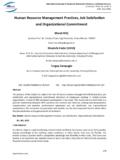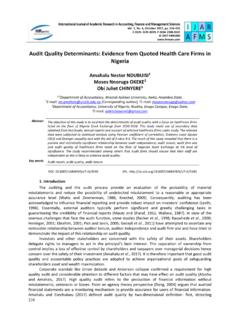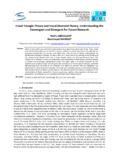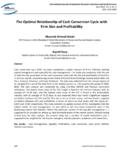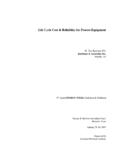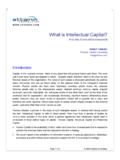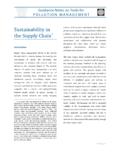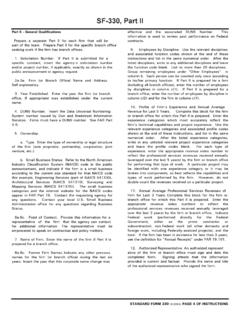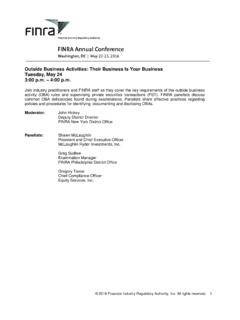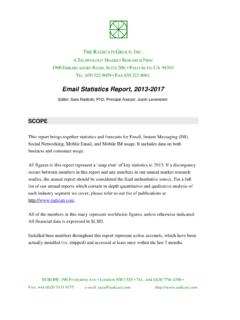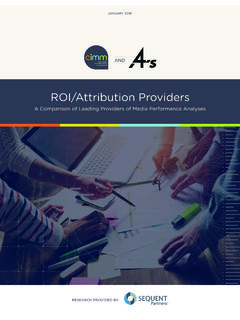Transcription of Effects of Working Capital Management on Firm …
1 International Journal of Academic Research in Business and Social Sciences June 2014, Vol. 4, No. 6 ISSN: 2222-6990 114 Effects of Working Capital Management on firm Performance: An Empirical Study of Non-financial listed Firms in Pakistan Naeem Ul Hassan Lahore Leads University, Lahore, Pakistan Corresponding email: Malik Muhammad Imran Lahore Leads University, Lahore, Pakistan Muhammad Amjad Leads Lahore University,Lahore, Pakistan Mehboob Hussain Bahauddin Zakariya University, Multan, Pakistan DOI: URL: Abstract The purpose of this paper is to investigate whether Working Capital Management affect the performance of non-financial listed firms in Pakistan. Panel econometric technique namely pooled ordinary least squares is used to estimate the relationship between Working Capital and firm performance.
2 Data were taken from the annual reports of non-financial firms listed on the Karachi Stock Exchange Pakistan during 2007-2010. Three performance measures namely gross profit margin, return on asset, and return on equity are used to estimate the impact of Working Capital variables such as average age of inventory, average collection period, and average payment period. Empirical results indicate that average age of inventory is positively related to gross profit margin and return on asset, whereas it is negatively related to return on equity but the relationship is found insignificant. Although the relationship is insignificant but positive sign may be because of increasing sales which leads to higher profit and thus fewer inventories.
3 Average collection period is significantly and positively related to gross profit margin and return on assets. This finding shows that Management of receivables has a positive impact on firm performance. Moreover, it confirms the prediction that reduction in average collection period improves the accounts receivable turnover which in turn positively affects the firm s profitability. Although average collection period is positively related to return on equity but the relationship is found insignificant. Average payment period is positively related to gross profit margin and negatively related to return on asset but the relationship is found insignificant. However, average payment period is positively and significantly related to return on equity.
4 International Journal of Academic Research in Business and Social Sciences June 2014, Vol. 4, No. 6 ISSN: 2222-6990 115 This finding indicates that stretching the payment period increases the firm s ability to utilize creditors money in their operation which in turn enhances the firm value. As far as control variables are concerned, a significant positive relationship is observed between firm size and two performance measures such as gross profit margin and return on asset. Alternatively, firm size is negatively related to return on equity but the relationship is found insignificant. Leverage is negatively and significantly related to gross profit margin and return on asset. Alternatively, an insignificant and positive relationship is observed between leverage and return on equity.
5 The negative relationship between leverage and profitably confirms the predictions of the pecking order theory which suggests that profitable firms tend to borrow less due to their ability generate funds from internal sources. Finally, firm age is negatively related to gross profit margin and return on asset whereas it is positively related to return on equity. However, the relationship is found insignificant. In sum these empirical findings indicate that Management of Working Capital has material affects of firm performance. Keywords: Working Capital , gross profit margin, return on asset, return on equity, non financial firms, non-financial firms. 1. Introduction Corporate finance mostly focused on the long term financial decision according to previous research.
6 Researchers mostly emphasize on studies of analyzing Capital structure, investment, company valuation or dividends, among different topics. But also focus on the investment in short term assets, and the resources employed with maturities within one year, which indicate the major share of items of firm s balance sheet. In fact, in this current study, current assets of non financial firms present 69 percent of their assets, and at the same time their current liabilities stand for more than 52 percent of their liabilities. Working Capital Management is very vital because of its outcome on the company performance and risk, and consequently its worth (Smith, 1980). Working Capital Management plays a very important job in tradeoff between firm s performance and risk.
7 Decision that engages improving profitability also increase the risk, and alternatively, decision that engages on risk decreasing will also decrease profitability. Gitman (1974) propose that cash conversion cycle was very important constituent in Working Capital Management . Actually, decision about how much spend in inventory and how much invest in customer, and how much accrued accept from supplier, are largely impact on the company cash conversion cycle, which point out the average number of days between the date when the company starts paying its supplier and the date when it begin to gather payment from its customer. Earlier research have focused on the cash conversion cycle to look at whether shortening this cycle has positive or negative Effects on performance.
8 Empirical proof points out that Working Capital Management and firm s performance in general hold up the fact or not that violent Working Capital policies get better profitability (Jose et al., 1996; Shin and Soenen, 1998; for US; Deloof, 2003; for Belgian firms; Wang (2002) for Japanies and Taiwan firms). This demonstrates that Working Capital investment policies is to perk up profitability. The companies show assets in the balance sheets, and liabilities are owned by it. The difference between total assets and total liabilities of companies equals to net value. Net value is equal to shareholder equity. Assets, liabilities and net worth values are computed at historical costs. Generally Accepted Accounting Standards (GAAP) requires this.
9 In Pakistan, these standards are International Journal of Academic Research in Business and Social Sciences June 2014, Vol. 4, No. 6 ISSN: 2222-6990 116 mainly stood on American and British rules, although international accounting standards (IAC) are also gaining in importance as orientation criteria. The security and Exchange Commission of Pakistan (SECP) modifies accounting process time to time. These previous researches have support their analysis on larger firms. However, the Management of current assets and current liabilities is very important in the case of non financial firms. Major companies assets are represents in the form of current assets. Also short term liabilities are one of their big resources of external finance because they face problems in achieving funding in the long term Capital markets (Petersen and Rajan, 1997) and the financing problems that they encounter (Whited, 1992; Fazzari and Petersen, 1993).
10 In this respect, Elliehausen and Wolken (19993), Petersen and Rajan (1997) and Danielson and Scott (2000) explain that non financial firms of Pakistan use vendor financing when they have run out of debt. Thus, efficient Working Capital Management is very important for smaller firms (Peel and Wilson, 1996). The objective of the current work is to provide empirical evidence about the Effects of Working Capital Management on profitability for a panel data of 48 non financial firms during the periods 2007-2010. This work divides the literature in two ways. First, no such evidence exists for the case of non financial firms in previous studies. We select a sample of Pakistani SME firms was studied that run within so called continental model, that is characterized by its less developed Capital market (La Porta et al.)
